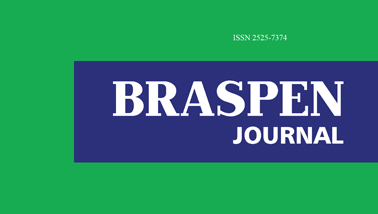Associação entre ferramenta de triagem e avaliação nutricional entre pacientes hospitalizados no município de Porto Alegre
Association between screening tool and nutritional assessment among hospitalized patients in the city of Porto Alegre
Camila Weschenfelder, Luciane Vieira Figueira, Talita Sthephanie Scotta Cabral, Jacqueline Schaurich dos Santos
Resumo
Introdução: A desnutrição hospitalar está associada à piora do estado geral do paciente e seu diagnóstico precoce possibilita a redução de complicações relacionadas. O objetivo deste trabalho foi verificar a concordância entre a ferramenta de triagem Short Nutritional Assessment Questionnaire (SNAQ) e a Avaliação Subjetiva Global (ASG). Método: Estudo transversal, realizado em um hospital geral na cidade de Porto Alegre (RS). A SNAQ foi aplicada por nutricionistas e enfermeiros previamente treinados, sendo o paciente considerado em risco nutricional quando o escore foi ≥2. A ASG foi aplicada por nutricionistas em todos os pacientes e considerada padrão-ouro para comparação. O coeficiente Kappa foi utilizado para a avaliação do grau de concordância entre as ferramentas de triagem e avaliação nutricional. Foi considerado valor de Kappa entre 0,21-0,60 como baixa concordância, 0,61-0,8 como concordância moderada e maior que 0,81, como forte concordância. Resultados: Entre janeiro e março de 2017, foram avaliados 186 pacientes, sendo 115 (62%) mulheres. A média de idade foi de 65,7 ± 16,6 anos e o índice de massa corporal (IMC) médio foi de 26,5 ± 5,5 kg/m². De acordo com a classificação da ASG, 73,7% da amostra foram considerados bem nutridos, 14% moderadamente desnutridos e 12,4% gravemente desnutridos. Foi observada baixa concordância entre o risco nutricional diagnosticado pela enfermagem vs. nutrição por meio da SNAQ (Kappa=0,58) e boa concordância da SNAQ aplicada pela equipe de nutrição com o diagnóstico nutricional da ASG (Kappa= 0,73). A SNAQ apresentou sensibilidade de 85,7% (IC95% 73,3 - 92,9) e especificidade de 90,5% (IC95% 84,4 - 94,4); valor preditivo positivo de 76,4% (IC95% 65,7 – 84,5) e valor preditivo negativo de 94,7% (IC95% 90 – 97,2). Conclusão: Concluímos que a ferramenta de triagem SNAQ, quando conduzida por nutricionistas, pode ser utilizada para detecção precoce da desnutrição hospitalar.
Palavras-chave
Abstract
Introduction: Hospital malnutrition is associated with the worsening of the patient’s general condition and its early diagnosis allows the reduction of related complications. The aim of this study was to verify the agreement of the Short Nutritional Assessment Questionnaire (SNAQ) screening tool and the Subjective Global Assessment (SGA). Methods: Cross-sectional study, carried out in a general hospital in the city of Porto Alegre (RS). The SNAQ was applied by previously trained nutritionists and nurses, and the patient was considered at nutritional risk when the score was ≥2. SGA was applied by nutritionists in all patients and considered the gold standard for comparison. The Kappa coefficient was used to assess the degree of agreement between the screening and nutritional assessment tools. Kappa values between 0.21-0.60 were considered as low agreement, 0.61-0.8 as moderate agreement and greater than 0.81, as strong agreement. Results: Between January and March 2017, 186 patients were evaluated, of them 115 (62%) were women. The mean age was 65.7 ± 16.6 years and the body mass index (BMI) mean was 26.5 ± 5.5 kg/ m². According to SGA classification, 73.7% of the sample was considered to be well nourished, 14% moderately malnourished and 12.4% severely malnourished. Low agreement was observed between the nutritional risk diagnosed by nursing vs. nutrition through SNAQ (Kappa=0.58) and good agreement of SNAQ applied by the nutrition team with the nutritional diagnosis of SGA (Kappa=0.73). The SNAQ presented sensitivity of 85.7% (95% CI 73.3 - 92.9) and specificity of 90.5% (95% CI 84.4 - 94.4); positive predictive value of 76.4% (95% CI 65.7 - 84.5) and negative predictive value of 94.7% (95% CI 90 - 97.2). Conclusion: We conclude that the screening tool SNAQ when conducted by nutritionists can be used for early detection of hospital malnutrition.

